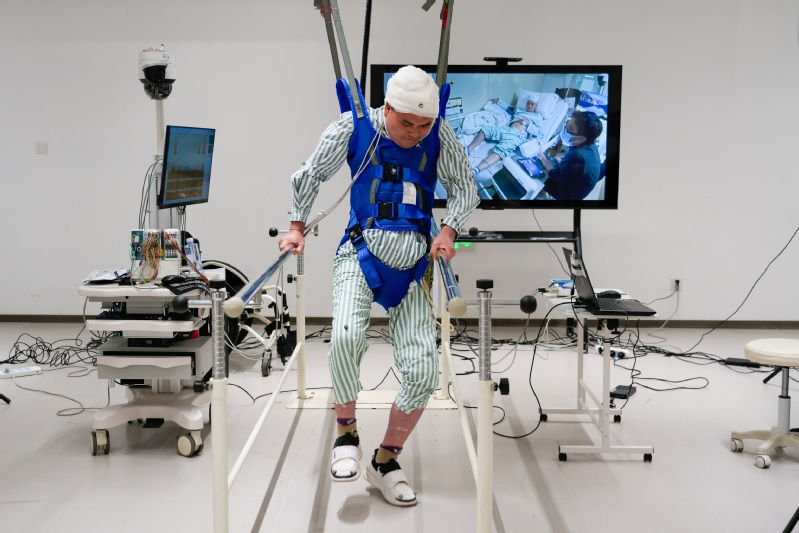New Paralysis Treatment in China: BCI Breakthrough Helps Patients Walk Again
- MedBridge NZ
- Oct 8
- 3 min read
For millions living with paralysis, the search for effective paralysis treatment in China and worldwide has led to a major breakthrough. A revolutionary technology is turning the dream of walking again into a reality. However, recent breakthroughs in Brain-Computer Interface (BCI) and Brain-Spine Interface (BSI) technology are turning this dream into a tangible reality, offering a new dawn for patients who have been told they may never regain movement.

A Leap Forward in Neurological Rehabilitation
In a groundbreaking development, a team at Fudan University's Institute of Science and Technology for Brain-Inspired Intelligence (ISTBI), led by Professor Jia Fumin, has successfully enabled a paralyzed patient to walk again. This was achieved through a minimally invasive Brain-Spine Interface (BSI) surgery performed at HuaShan Hospital Fudan University. The patient, who had been paralyzed for two years due to a spinal cord injury, regained movement in his legs just one day after the procedure.
This remarkable achievement was made possible by the world's first "triple-integrated brain-spine interface technology." The innovative system uses AI to create a "nerve bypass," implanting electrodes to re-establish the connection between the brain and the spinal cord segments responsible for walking. This procedure represents a monumental leap in neural functional reconstruction and offers a scalable solution with the potential to help a vast number of patients.
How Does Brain-Computer Interface Technology Work?
At its core, BCI technology creates a direct communication pathway between the brain's electrical activity and an external device. In the context of paralysis, it can bypass the damaged part of the spinal cord. When a person thinks about moving their legs, the BCI captures these neural signals, and a computer deciphers them. The computer then sends commands to a stimulation device on the spinal cord or directly to the leg muscles, initiating the intended movement.
This technology is not just a scientific marvel; it is a life-changing intervention that can restore dignity, independence, and hope to those affected by paralysis. The success of these initial surgeries is a powerful testament to the potential of BCI and BSI to revolutionize the rehabilitation of stroke and spinal cord injury patients.
Seeking Advanced Paralysis Treatment in China
This pioneering work solidifies China's role as a leading destination for advanced neurological care. For international patients considering paralysis treatment in China, navigating the healthcare landscape can be daunting. This is where a dedicated medical concierge provider can be invaluable.
If you are exploring the possibility of Medical Tourism China, our services are designed to provide you with seamless access to world-class medical facilities and experts. We handle all the logistics, from hospital appointments to travel and accommodation, allowing you to focus solely on your health and recovery. We are not a medical provider, but we are your trusted partner in your journey towards healing.
The future of paralysis treatment is brighter than ever. With ongoing research and the successful clinical application of BCI and BSI technologies, we are entering a new era of hope and possibility for patients around the world.
This article was written based on research and clinical advancements led by Chinese medical experts. The information herein is for educational purposes and should not be considered medical advice.
Source Attribution:
Part of this article is based on the work of Dr. Cao Xiao, Lecturer and Associate Chief Physician at the Department of Neurological Rehabilitation, National Rehabilitation Auxiliary Research Center Affiliated Rehabilitation Hospital.
The clinical breakthrough mentioned is credited to the team led by Professor Jia Fumin at Fudan University's Institute of Science and Technology for Brain-Inspired Intelligence (ISTBI), in collaboration with HuaShan Hospital Fudan University and ZhongShan Hospital Fudan University.
References:
Cao, X. (n.d.). Brain-computer interface: a revolutionary breakthrough and reflection on the rehabilitation of stroke and spinal cord injury. Retrieved from https://www.haodf.com/neirong/wenzhang/9394189468.html
Fudan University. (2025, March 5). Fudan's AI Empowered BSI Enables Paralyzed Patients to Walk. Retrieved from https://www.fudan.edu.cn/en/2025/0305/c344a144344/page.htm



